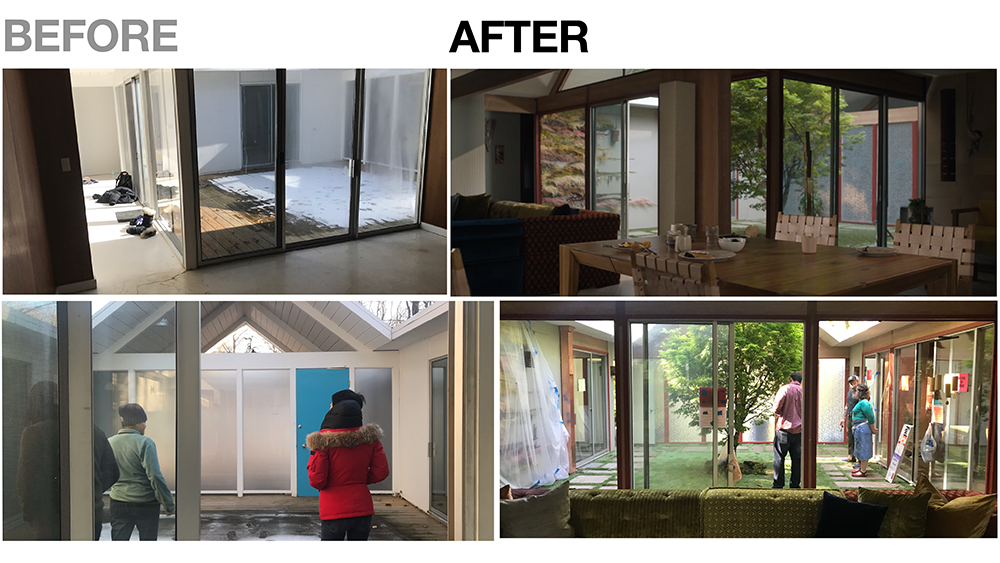
Production stills from After Yang.
The most architecturally aware film was After Yang by the American-based South Korean filmmaker Kogonada, not surprising after his first film Columbus (2017) set in the haven for mid-century Modern architecture in Indiana fostered by J. Irwin Miller of the Cummins Engine Company. In the new film, he presents a post-apocalyptical world a few years hence, where his implied question is “How do you consider the future”? His answer is by using a distinctive 1962 “tract house” Eichler Home in Chestnut Ridge, NY designed by architects Claude Oakland (Anshen + Allen) and Jones & Emmons, one of only three built outside of California where they flourished, as the main location. With flat roof, large glass sliding doors, and spacious courtyards, the physical space feels both Asian and Scandinavian (employing the Danish concept of hygge for contentment) as interpreted by production designer Alexandra Schaller, which sets the tone for this story about a “certified refurbished” android or technosapian named Yang who has stopped working. He is considered a member of the family composed of an interracial couple and their adopted Chinese daughter to whom Yang connects her Asian heritage. The tranquil home with all rooms facing a central courtyard, features distinctive lighting fixtures — a kitchen wall with horizontal light rods punctuated by a diagonal light slash, a geometric chandelier, a Noguchi-like paper-shade, fireplace lighting that is also a heating source. A self-driving car the father Jake (Colin Farrell) drives in his quest to get Yang repaired, utilized a Toyota Sera hatchback with butterfly doors and glass roof canopy that was only made for the Japanese market from 1990-96 which afforded Kogonada’s preference for shooting these scenes reflected in the glass, as we pass through tunnels which turn green when he drives beneath parks or blue to signify a waterway. Pottery used at home or in Jake’s stylish, minimalists tea shop, is by Japanese brand Kinto, or hand-thrown by artists, and no plastic was used at all by the art department to reflect a plastic-free world. We glimpse a cityscape with parabolic skyscrapers and an expansive dome, which could be from our time or the future. The director aimed for Japanese director Yasujirō Ozu’s (1903-1963) style of precise compositions, symmetry and tranquility. The film won the Sundance Alfred P. Sloan Feature Film Prize.
By contrast, an uncomfortable sense of home is felt in Counterfeit Kunkoo, which refers to the Marathi word for the red bindi dot married women wear on their foreheads. A “bachelorette” woman estranged from her abusive husband seeks a place to live on her own in Mumbai, but is no one will rent to her because she needs the approval of a spouse. Her bleak temporary lodgings are routinely shown to prospective tenants, even while she is there. She secures a flat through subterfuge saying that her husband is away, but is still hounded once she moves in by the landlord looking for her husband.
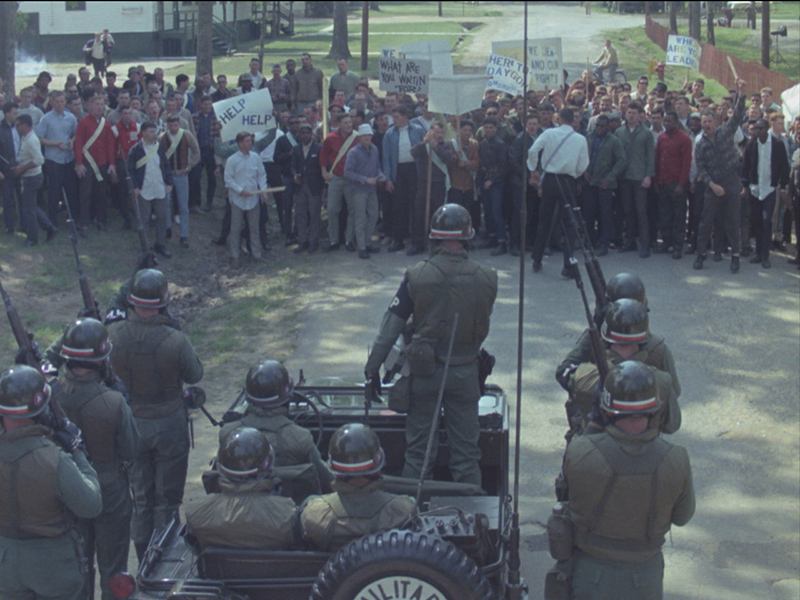
Still from Riotsville USA.
Ersatz townscapes were called riotsvilles in the film Riotsville USA which features these fictional towns constructed by the U.S. military to respond to 1960s unrest in such cities as Watts, Newark and Detroit. Located at Fort Belvoir, Virginia (named for a plantation), Fort Gordon, Georgia (after Confederate General John Brown Gordon), and other locales, they were used to train police and soldiers to fight protestors. Drawn entirely from archival footage, the film tracks along these main street business districts’ fake supermarkets, pawn shops, liquor stores, McDonald’s, clothing outlets and furniture emporia populated by uniformed personnel donning hippie clothes and wigs to play protestors, while their comrades fight them off. Also shown is June Jordan’s proposed public housing redesign called “Skyrise for Harlem” with communal towers designed by Buckminster Fuller at her request. An article by Jordan published in April 1965 Esquire, was titled “Instant Slum Clearance” against her wishes, helping to scupper the project.
A doomed city appears in Reckless where Stockholm is now a city underwater. As the camera submerges below the surface, we land on a ceiling fan which pans down to a Vitamin D refrigerator case in a deli where we overhear “It’s not like we can get out of here” and “This will be our grave” before hearing “Make a wish on the droplet” as we see pipes leak. Although repairmen try to fix the leaks across town, we follow our heroine home where we her kitchen window view “outside,” an underwater grid of buildings, exterior staircases gushing water. She is temporarily is saved by going out, not noticing water sprouting in her flat. It’s a climate crisis without the subject ever being mentioned. Director Petra Kagerman is herself an interior and set designer and studied architecture at Parsons.
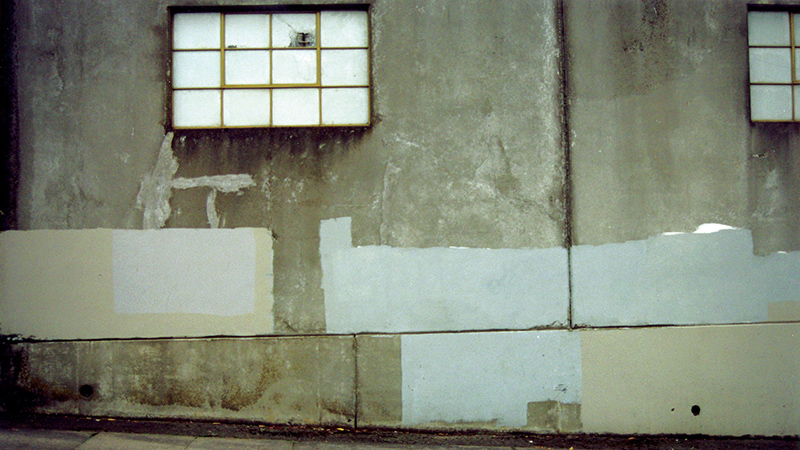
Still from The Subconscious Art of Graffiti Removal.
The Subconscious Art of Graffiti Removal is a different vanishing. Erasing unwanted tagging is declared its own art form, with the blocks of paint obliterating graffiti yielding a new, unintentional artwork in one of three styles: symmetrical, ghosting, and radical (outside the lines). It is even compared to the work of artists Mark Rothko and Kasimir Malevich, although with a distinct sense of irony. In FE26 scavengers remove copper wire, who justify their actions because the buildings are coming down in anyway.

Still from Sensual Pill.
Sensual Pill is an animated short made entirely of Google Earth Pro footage: a globe spinning, built environments on islands, overhead shots of cityscapes for a tapestry of airports, shipping containers and coastlines that ends with an ancient Pyramid.
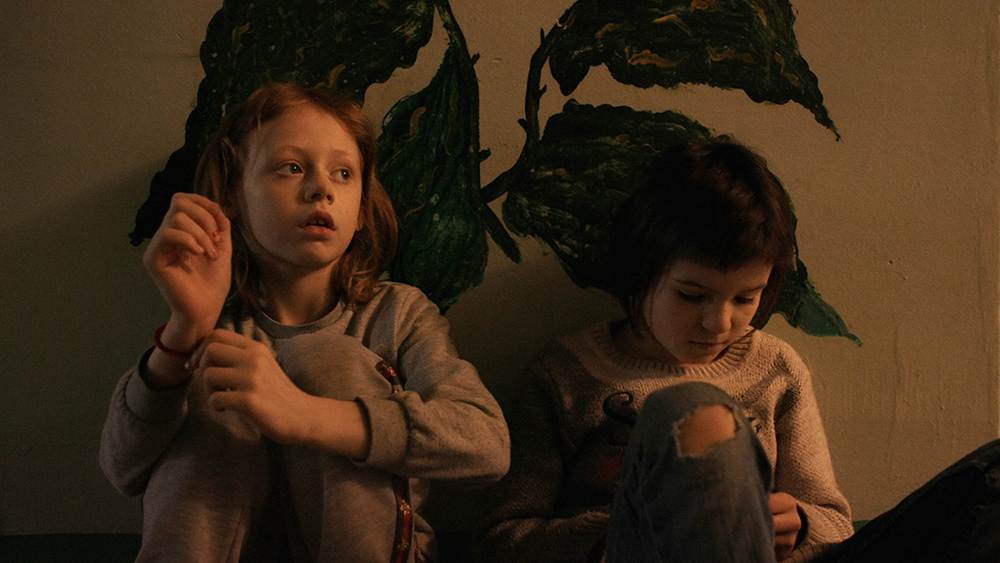
Still from House of Splinters.
A series of films showcased institutions and the instructional buildings that house them. House of Splinters which won the Sundance Directing Award: World Cinema Documentary, is Lysychansk Center for the Social and Psychological Rehabilitation of Children in Eastern Ukraine that temporarily shelters children for 9 months suffering from parental neglect, often due to alcoholism and drug use. Although the imposing Soviet-era building is cold and institutional, the kids are treated with warmth and humanity. “Our shelter is a house built of sorrow, but hope still flickers here. Every child leaves a lasting mark on the shelter’s worn-out walls.”
New Frontier, the Sundance section of multimedia, VR and emerging tech creative projects, had Diagnosia on the “camp” run by Tao Ran, psychiatrist colonel in the People’s Liberation Army and director of China Center for Public Economics and Governance at Renmin University in Beijing. Called the Adolescent Psychological Development Base founded in 2004, it claims to provide internet addiction rehabilitation. At a cost of $1400 per month, the parents of Diagnosia’s creator Mengtai Zhang Lemon Guo, sent him there in 2007 to fight what the Chinese consider “spiritual opiums” and “electronic heroin” for playing a video game called “Fight the Landlord.” The facility is spartan with bunk beds, desk and lamp in the bedrooms, grimy hallways painted green at the bottom and light blue at the top, and bleak classrooms with chairs, free-standing blackboards, and a few informational posters. Chain-link fencing covers the windows, and “inmates” wear camouflage fatigues. The author ended up in New York in 2018 where he lives in a spare apartment, not dissimilar from the one he occupied at the camp, and does Homeland Carrie Mathieson-style charts with red string connecting texts such as “first Internet cafe in China,” “first internet provider company in China,” and “the Great Firewall proposal,” trying to unravel what he underwent. “While China’s video game industry was condemned as the culprit of internet addiction, it was also tolerated for its economic contribution,” he says.
Listen to the Beat of Our Images laments the displacement of residents in French Guiana to make way for the Guiana Space Centre in Kourou opened in 1968 (it was used on Christmas Day 2021 for the Webb telescope launch). A modern city for Europeans was created with clean, white modern buildings and residents in sleek leotards enjoying sunny patios, swimming pools and motorboats for the the families of aerospace workers. Dos Estaciones centers on a majestic tequila factory in Agua Caliente, Jalisco, Mexico that features stately archways and gracious interiors, a business and lifestyle threatened by foreign multinational competitors that have located nearby. It won the Sundance World Cinema Dramatic Special Jury Award: Acting.
Vanished and vanishing worlds were made visible in a cache of films, starting with non-fiction films. 575 Castro Street is the address of Castro Camera, the assassinated gay elected official Harvey Milk’s camera store in San Francisco. For the biographical film Milk (2008), for which Sean Penn won an Oscar, directed by Gus Van Sant, the interior was faithfully recreated and captured on the film footage which comprises this documentary portrait of the storefront. The patinated interior with grey and black squared linoleum flooring, cinderblock walls, photo of a Victorian house’s architectural detail, lots of rag-tag used furniture such as a red velour sofa, green brocaded armchair, turquoise desk with wooden top, green pegboard hung with Ilford film envelopes, wooden breakfront holding boxes of film in diagonal cross-hatched shelving and a Kodak illuminated light on the wall. Milk’s campaign posters for his run for the Board of Supervisors hang throughout. The soundtrack is a tape Milk recorded on November 18, 1977 meant to be played in the event that he is slain.
Three Minutes - A Lengthening, is rediscovered 1938 home movie footage shot in the mostly Jewish town of Nasielsk, Poland that captured a world soon to vanish in the Holocaust beginning the next year. Displaced is set in Kosovo where a ping pong team and their wheeled table relocate from garage to banquet hall to food warehouse to church to school looking for a spot to coach kids. The coach is a construction workers, so we follow him to building sites as well. It won the Sundance Short Film Jury Award: Nonfiction,
Features also portrayed disappearing venues. Utama, winner of the Sundance World Cinema Grand Jury Prize, translates as “our home” in Quechuan in this poignant Bolivian film about an aboriginal llama shepherd in the Andean high plains and his fading lifestyle as their town is abandoned due to drought. Klondike shows the Donetsk region of eastern Ukraine, the site of current tension with Russia, where a house occupied by a pregnant farming couple is bombed in separatist attacks by Russian and Chechnians in the 2014 Donbas conflict that also downed Malaysian Airlines Flight 17 which killed all onboard. The couple continues to live in the bombed-out home and try to rebuilt amid the continued onslaught. It won the Directing Award for World Cinema at Sundance.
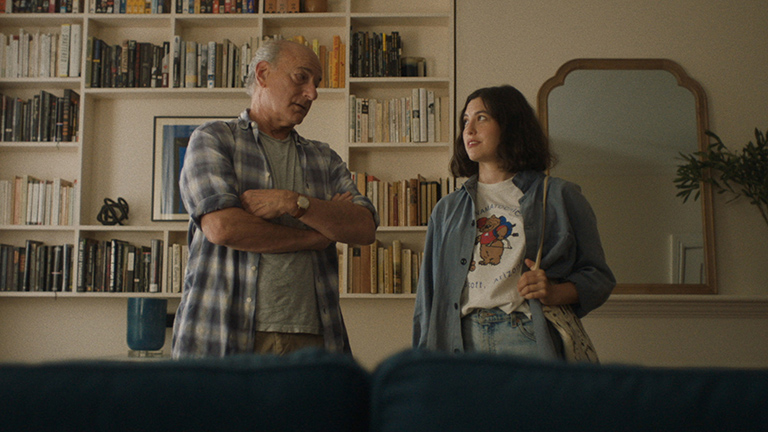
Still from Daddy’s Girl.
A milder escape is Daddy’s Girl, where a father helps his daughter move out of her boyfriend’s beautiful apartment. After getting high, they decide it’s a great idea to steal his blue couch from ABC Carpet & Home.
An absurder form of vanishing is in Little Berlin where a German farming community is literally divided down the middle after WWII, separating the cows into East and West, with deadpan narration by Christoph Waltz.
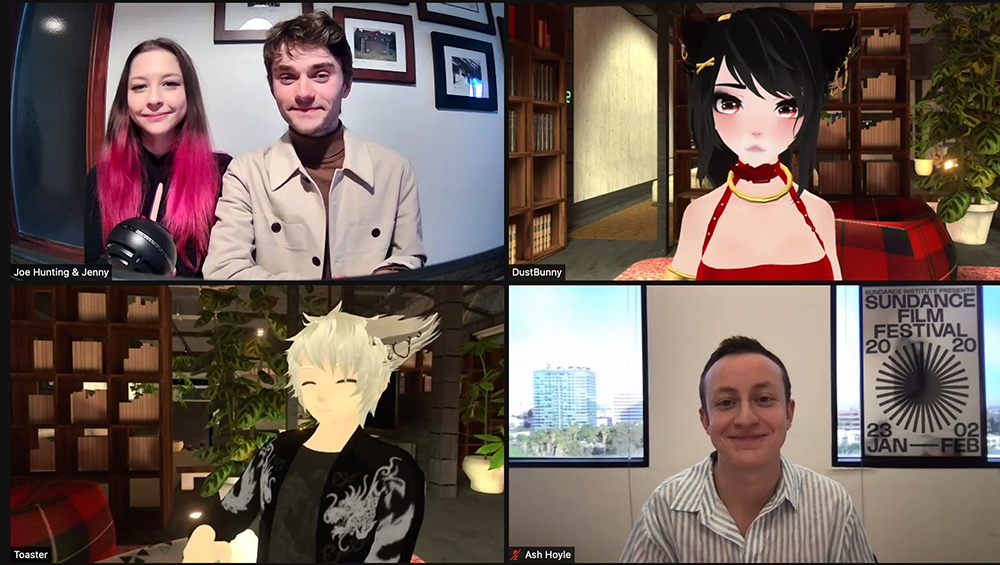
Still from We Met in Virtual Reality.
Another batch of films were about invention. We Met in Virtual Reality https://www.dailymotion.com/video/x87boe5 is populated by animated avatars of people who hang out, socialize, teach, and even marry in online space in belly dancing classes, sign language lessons, and hotly contested billiards games. The film takes place during COVID and VR was a lifesaver for many who relish the fact that no one knows your true identity, how old you are, or other personal facts. But rather than seeing this as a way to exploit, con or do harm, the participants find VR freeing. In fact, one says that falling in love is purer than in real life because you can’t touch, can’t see a person’s face, you only experience who they really are. Most avatars are sexy women, virile men, anime, in bright, cheeky, childlike personae. We never see anyone meet in real life, which might prove a disappointment.
Brian and Charles are an inventor and his robot, who live in a small village in Wales. Brian invents oddball things like an egg belt, a pine cone bag, a cabbage canon and a super-shower projectile and finally a robot, Charles, who sports a dummy’s head, washing machine body and wears a bow tie, khakis, and eyeglasses over one illuminated glass eye. The pair gets into scrapes, which they evade with the help of Brians other unlikely inventions.
In the first of a planned series of films about filmmakers’ early career struggles, Lewie and Noah Kloster made an animated film with cardboard figures and sets for Stranger than Rotterdam that won the Sundance Short Film Special Jury Award: Screenwriting. This tale of getting Jim Jarmusch’s unfinished film Stranger than Paradise (1984) to the Rotterdam film festival so that producer Sara Driver could raise completion financing, was accomplished by hand-carrying the contraband, still unreleased Cocksucker Blues (1972), Robert Frank’s film of the Rolling Stones Exile on Main St. tour. Another artist who works in cardboard is Brent Brown, The Sticklet Weaver, who makes puppets, superheroes, animals, pirates and cartoon characters, despite his learning disability. Similarly South is an autistic boy who models cartoon figures out of clay in a room he called the “lab.”
32 Sounds, another New Frontier offering meant to be experienced with a VR headset, explores “elemental phenomenon of sound and how it affects our conscious and unconscious lives” with chapters about the “power of sound to bend time, cross borders, and profoundly shape our perception of the world.” Citing Charles Babbidge (1791–1871), the English polymath who originated the concept of a computer who said “the air itself is a library” we visit avant-garde composer Annea Lockwood (Piano Burning in 1968 and now), Philip Glass, Laurie Anderson, deaf sound artist Christine Son Kim (who performed at the Super Bowl), John Cage (4’ 33” performance in 1971), and Lebanese physicist Edgar Choueiri listening to a tape of his 11-year old self.
Show Me Other Places frames the world, natural and man-made, real and virtual, by accessing places in digital form while situated in front of a computer screen. It questions the relationship between the creator, tool and subject and shows overhead shots of construction/destruction sites.

Still from Watcher.
The pandemic seems to have been fertile ground for horror films. Watcher puts an American woman in Bucharest where she is constantly watching, and being watched. A new arrival with her Rumanian-American husband, they move into a spacious apartment across the street from a Brutalist apartment block with large windows. We explore the new city with her at a subway station with arched white lights and the classical General City Hall with Ionic columns, triangular pediment, and ornate domed lobby festooned with fluted capitals and mosaic floor. She is small in the frame against massive environments, and dressed in a wardrobe that starts off with bright colors and shifts to neutrals where she blends into the background. In fact, she is being spied on from across the way.
Speak No Evil starts in an idyllic Tuscan resort where the room ceilings have painted coffers and diners sit outdoors under long pergolas. The nearby town has picturesque narrow streets and archways, a walled city from which one can gaze to the countryside. A Danish family returns home to a modern glass apartment building with blue LED lights, who then visit a Dutch family they met in Italy. Their isolated two-story peaked-roof brown & white sided house with brick-walled interiors is where mayhem happens. The end credits are over a ceiling putto (winged angel) frieze in an octagonal gilded frame with an arm covering its mouth.
Nanny, winner of the Sundance U.S. Grand Jury Prize: Dramatic is a Somalian immigrant who works for a wealthy white couple in a new high-rise on the Brooklyn/Queens waterfront with large windows, contemporary art, black-trimmed doors, windows and pipes, dark walls, aqua shades and colored balls ornaments, mostly bronze. She enters through the elevator lobby which has white and black mosaic floor and herringbone brick walls. This is contrasted with her modest apartment which is brightly colored in pink, red, and ochre. The horror aspect comes from a haunting communicated through water.
Alice takes place on a quintessential Georgia plantation — neoclassical house with white triangular pediment and columns, black shutters, lunette window over the front door, and a bedroom with a four-poster bed and red-painted walls. She a she is a slave, and lives in a rundown one-room shack. We also see contrasting cemeteries, one for Blacks that has simple, weathered white crosses and one for White with stone headstones. When she escapes, she runs onto a …..highway and discovers the year is 1973.
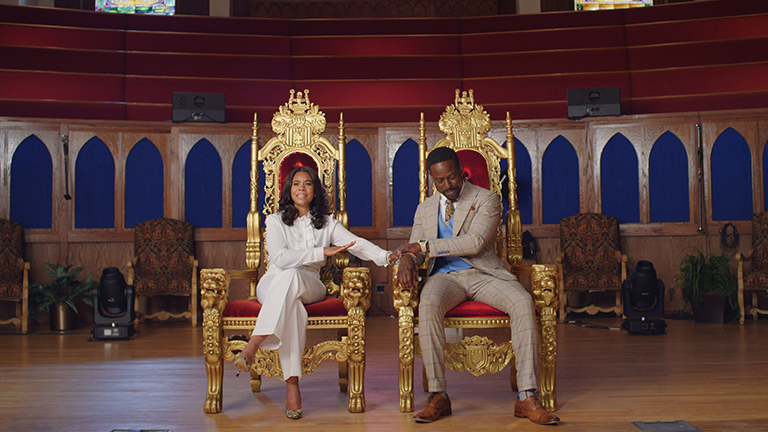
Still from Honk for Jesus, Save Your Soul.
The Atlanta minister and his “first lady” in Honk for Jesus, Save Your Soul live in a McMansion with large exterior staircase, grey stucco exterior and gaudy nouveau furnishings including a giant chandelier. Their Greater Paths Baptist megachurch with giant spire, indoor fountain, red decor, white tiled floor with black squares, and thrones where the couple perch, was flourishing until a scandal. Their rivals who run a nearby church, Heaven’s House, has benefited, siphoning off their congregation into a more modern structure.
A Stepford-like suburb in Finland is where Hatching occurs. The father is an architect, while his wife has a video blog called “Lovely Everyday Life” where she chronicles her daughter, a gymnast whose bedroom sports a big pink rose motif, her son and their “perfect” life. A bird flies into the living room creating havoc, breaking glasses and the chandelier, which starts the sinister transformation of its avian offspring. (Another film set in a cookie-cutter planned community — its only menace — is Sylvie of the Sunshine State, in sunny Delray Beach, Florida, chronicling life with COVID by a filmmaker mother and her 9-year old daughter. which won the George Starks Spirit of Slamdance Award.) https://drive.google.com/file/d/1jr-SJxVxku4f2e8CdVNn9FqGCgADpYrH/view
Something in the Dirt begins with Levi moving into a no-lease apartment where. he meets a long-term resident, John. Supernatural phenomena such as objects levitating, is witnessed by both men who decide to become documentarians to capture the scientific and metaphysical interactions with real space.
After seeing these unnerving films, I was happy to be in my own domicile, rather than the cinema.
SUNDANCE FILMS
32 Sounds, directed by Sam Green
575 Castro St., directed by Jenni Olson
A House Made of Splinters, directed by Simon Lereng Wilmont
After Yang, directed by Kogonada
Alice, directed by Krystin Ver Linden
Brian and Charles, directed by Jim Archer
Counterfeit Kunkoo, directed by Reema Maya (aka Reema Sengupta)
Daddy’s Girl, directed by Lena Hudson
Diagnosia, directed by "Mengtai Zhang and Lemon Guo"
Displaced, directed by Samir Karahoda
Hatching, directed by Hanna Bergholm
Honk for Jesus, Save Your Soul, directed by Adamma Ebo
Klondike, directed by Maryna Er Gorbach
Listen to the Beat of Our Images, directed by Audrey Jean-Baptiste and Maxime Jean-Baptiste
Nanny, directed by Nikyatu Jusu
Reckless, directed by Pella Kågerman
Riotsville, USA, directed by Sierra Pettengill
Something in the Dirt, directed by Justin Benson and Aaron Moorhead
Speak No Evil, directed by Christian Tafdrup
Stranger than Rotterdam with Sara Driver, directed by Lewie Kloster and Noah Kloster
The Subconscious Art of Graffiti Removal, directed by Matt McCormick
Three Minutes - A Lengtehning, directed by Bianca Stigter
Utama, directed by Alejandro Loayza Grisi
Watcher, directed by Chloe Okuno
We Met in Virtual Reality, directed by Joe Hunting
SLAMDANCE FILMS
Little Berlin, directed by Kate McMullen
Sensual Pill, directed by Sam3
Show Me Other Places, directed by Rajee Samarashinghe
South, directed by Kyle Gibbins
The Sticklet Weaver, directed by James Hollenbaugh
Sylvie of the Sunshine State, directed by Sasha Levinson
